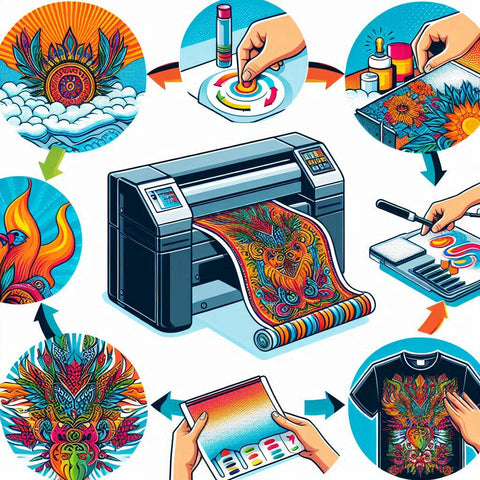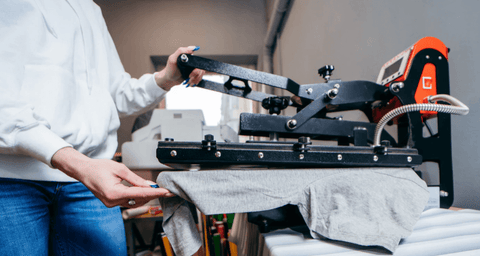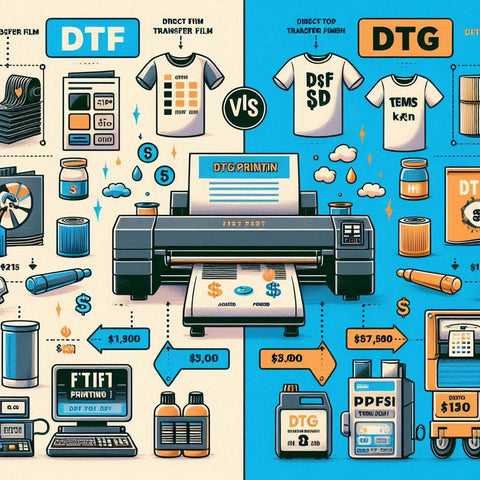DTF (Direct-to-Film) printing is a digital transfer method used to print designs onto various fabrics. It involves printing designs onto a special film and then transferring them to the fabric using heat and pressure. Here’s a step-by-step explanation of how DTF printing works:
Step-by-Step Process of DTF Printing
-
Design Creation:
- Graphic Design: The process begins with creating or selecting a design using graphic design software like Adobe Photoshop or Illustrator. The design should be prepared in high resolution to ensure a quality print.
- Color Management: It’s important to manage colors correctly in the design software, especially if vibrant colors are required. This includes setting up the file in the correct color mode (usually CMYK) and ensuring that any white areas are appropriately marked.
-
Printing on the DTF Film:
- DTF Printer: The design is printed onto a special PET (polyethylene terephthalate) film using a DTF printer. This printer uses specially formulated DTF inks, which are more durable and vibrant than standard inks.
- Layering: The printer first lays down a white layer of ink on the film to act as a base for the colors. This is crucial for ensuring the design stands out on any color fabric.
- Color Ink Layer: After the white layer, the printer applies the colored inks directly on top. The result is a vibrant and high-quality print on the film.
-
Application of Adhesive Powder:
- Powder Coating: Once the design is printed on the film, a special adhesive powder is applied to the printed side of the film. This powder sticks to the wet ink and acts as the adhesive that will bond the ink to the fabric.
- Even Distribution: The powder must be applied evenly to ensure that the transfer adheres properly across the entire design.
-
Curing the Adhesive Powder:
- Curing Oven or Heat Press: The film with the adhesive powder is then passed through a curing oven or placed under a heat press to melt the powder. The curing process activates the adhesive, making it sticky and ready for transfer.
- Proper Temperature: It’s important to cure the powder at the right temperature (usually around 250°F to 300°F or 120°C to 150°C) to ensure proper adhesion without damaging the film or ink.
-
Transferring the Design to Fabric:
- Heat Press Setup: Once the film is cured, it’s ready to be transferred to the fabric. The fabric is placed on the heat press, and the printed film is positioned on top of the fabric with the ink side facing down.
- Heat and Pressure: The heat press is then closed, applying heat and pressure to the film. Typical settings are around 300°F to 325°F (150°C to 160°C) for 10 to 15 seconds with medium to firm pressure.
- Transfer Activation: The heat melts the adhesive powder again, allowing it to bond the ink to the fabric.
-
Peeling the Film:
- Peel Type: Depending on the type of DTF film used, the film can be peeled off either hot (immediately after pressing) or cold (after cooling).
- Peeling Process: Carefully peel the film away from the fabric. If the transfer is a hot peel, do this immediately after pressing. If it’s a cold peel, wait for the film to cool down completely before peeling it away.
-
Final Press (Optional):
- Re-Pressing: For added durability and to ensure that the design is fully set into the fabric, a second press can be done for about 5-10 seconds. This step helps to improve the washability and longevity of the print.
- Protective Sheet: It’s recommended to use a Teflon sheet or parchment paper over the design during the final press to protect the print and avoid direct contact with the heat plate.
Benefits of DTF Printing
- Versatility: DTF printing can be used on a wide range of fabrics, including cotton, polyester, blends, nylon, and more. This makes it suitable for various applications, from T-shirts to bags and hats.
- Durability: DTF prints are highly durable, withstanding multiple washes without fading or cracking. This is due to the strong bond formed between the ink and the fabric.
- Vibrant Colors and Details: DTF printing produces vibrant colors and can capture fine details in the design, making it ideal for complex and colorful graphics.
- Soft Feel: The prints are typically soft to the touch, maintaining the comfort of the fabric and making them suitable for everyday wear.
By following this process, DTF printing provides a reliable and high-quality method for creating custom apparel and fabric goods, making it a popular choice for both small businesses and large-scale production.





Comments (0)
There are no comments for this article. Be the first one to leave a message!